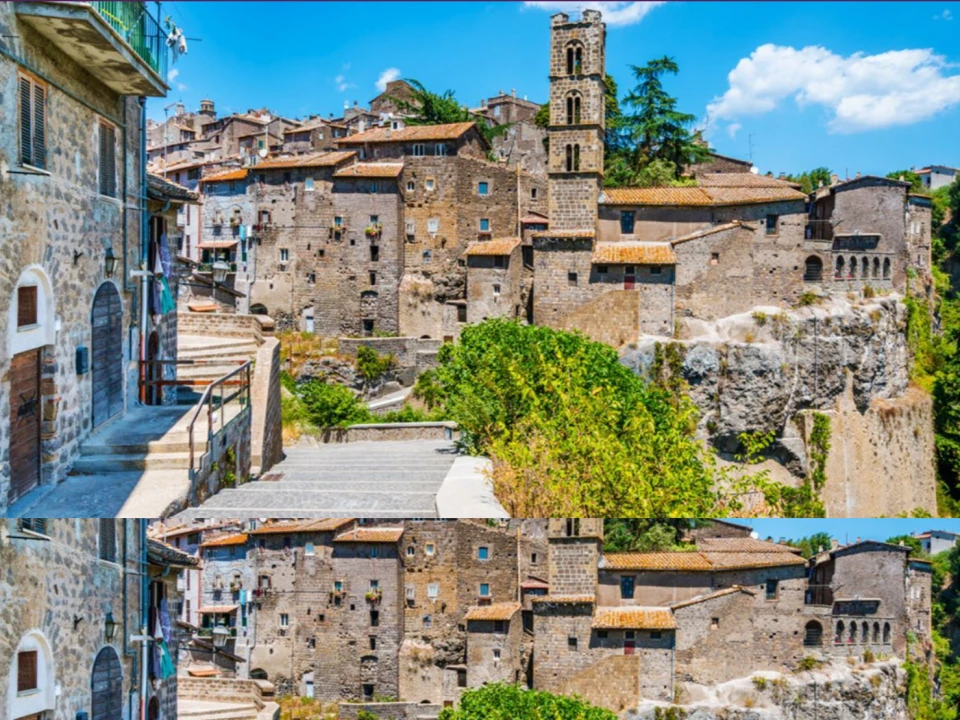"La Rocca" erected in the Middle Ages by the Prefects of Vico to guard the only natural access to the town, it was the prerogative of the Counts of Anguillara, Della Rovere and Farnese families and underwent major changes, particularly between 1475 and 1480 with the renovation ordered by Pope Sixtus IV and entrusted to the Florentine architect Giovanni Dolci, who added the circular keep and the four fortified towers at the corners, which among other things gave the castle its current popular name "I Torrioni."
"Fontana Grande or degli Unicorni" built by architect Antonio Gentili da Faenza in sandstone, features three unicorns from whose mouths water gushes out to fill the two basins below.
"Porta Romana" built in 1618 at the behest of Cardinal Odoardo Farnese dal Vignola currently divides the historic center of the town from the southern area.
"House Museum of the Venerable Mariangela Virgili" this is the house, now turned into a museum by the faithful of Mariangela Virgili, a Carmelite Tertiary of the Ancient Observance, on whose person a beatification process is underway. The Virgili's palace, located in the most characteristic corner of Piazza degli Angeli in the medieval village, with the noble coat of arms on the front of the entrance door is one of the most interesting monuments of Ronciglione's historic center.
"The Museum of the Old Ironworks" is set up in the oldest ironworks in the town owned by the former Mattei family, located in Via delle Cartiere, a place that tells the industrial, economic and social history of the town. Ronciglione recognized as one of the most active industrial steel poles in the Papal States since the early 15th century, was home to 15 active ironworks along the course of the Rio Vicano along with other factories. The Rio Vicano artificial effluent of Lake Vico was synonymous with life and work for Ronciglione and allowed the town to become a historical landmark in the iron industry; it dictated the rules of the town's urban development, imposing, for example, the wide streets that characterize the town. The oldest ironworks was also the last to close its doors, remaining active until 1992.
The Rio Vicano valley is crossed, south of Ronciglione, by the single-arch "Iron Bridge" of the Civitavecchia-Orte railway line, closed to traffic in 1994, of which the old station remains, a fascinating setting for many films. The bridge was built in 1928 by Officine Savigliano with a structure consisting of parts hinged together, according to an isostatic scheme chosen because of the yielding nature of the ground.
"Lake Vico" is probably the best preserved among Italian lakes of volcanic origin, as well as being the highest in Italy above sea level. Included among the areas of special natural value in Lazio and part of the Lake Vico Nature Reserve allows the development of life for rare and numerous animal species. According to legend, Lake Vico was formed by the water that gushed out after Hercules pulled out the club he had previously stuck in the ground to challenge the locals and which no one had been able to remove. The demigod, in fact, is said to have come to Ronciglione in search of the nymphs Melissa and Amalthea and also for this he wanted to demonstrate his great vigor.
The name
The origin of the name is uncertain. Some scholars claim it comes from the root rum or rom of Etruscan origin. Others assert that it derives from Runcola or Roncilio, leaning on the fact that for many years already, hummers and iron agricultural implements were manufactured there. But the most credited hypothesis seems to be that it derives from the cliff made in the shape of Roncola, on which the ancient settlement stands, Bedini asserts that " the name Ronciglione came from the conformation of the massif" on which it was built: massiccio rotondeggiante (rounded massif) = rotonduscilio -> rondus cilio -> roncilio -> Ronciglione.
History
The oldest document in which the name of Ronciglione is mentioned dates back to 1103. Cipriano Manente, a 16th-century Orvieto historian, puts the approximate date of foundation at 1045 by intervention of the prefects of Vico. In 1526 Ronciglione came into the possession of the Farnese family, and it was under their shrewd rule that it experienced its period of greatest development and splendor (1526-1649). It was a county under the dependencies of the Duchy of Castro. It was an economically advanced center for the vast manufacturing apparatus: ironworks, coppersmiths, paper mills, ceramics, armories, printers, etc., and had a cultural vibrancy linked to various Academies (Desiderosi, Cimina, Arcadico Cimina, Erculea Cimina etc.) and printing presses where, among other things, the first Italian edition of Tassoni's Secchia Rapita (1642) and Tasso's Aminta were printed. In 1728 Pope Benedict XIII erected Ronciglione Città. The 18th century closed dramatically with the anti-French uprisings during the First Roman Republic of 1798-1799. The fire, set by General Valterre's French troops, raged from July 28-30, 1799 and destroyed 174 buildings and the entire Historical Archives.
The village dish
The "Tortorelli" of Ronciglione are a poor pasta made simply with water and flour kneaded and formed by hand. The name recalls the dialectal "Tortore," a term for a rough stick. Every family traditionally appreciates it for Sunday lunch.
"Pampapato" is the typical Christmas dessert made mainly with local hazelnuts and chocolate. Unlike Pampepato, which is characterized by the presence of pepper, this dessert does not include it and the name is probably linked to the opulence of the golden years of the Papal States.




